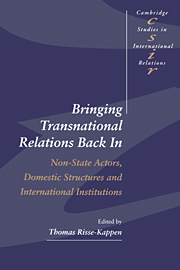 Bringing Transnational Relations Back In
Bringing Transnational Relations Back In Book contents
- Frontmatter
- Contents
- List of tables
- List of contributors
- Preface
- List of abbreviations
- Setting the agenda
- Case studies
- 2 Transnational relations and the development of European economic and monetary union
- 3 “Bullying,” “buying,” and “binding”: US–Japanese transnational relations and domestic structures
- 4 MNCs and developmentalism: domestic structure as an explanation for East Asian dynamism
- 5 Transnational relations, domestic structures, and security policy in the USSR and Russia
- 6 Mechanics of change: social movements, transnational coalitions, and the transformation processes in Eastern Europe
- 7 Ivory, conservation, and environmental transnational coalitions
- Conclusions: So what?
- Index
- CAMBRIDGE STUDIES IN INTERNATIONAL RELATIONS
6 - Mechanics of change: social movements, transnational coalitions, and the transformation processes in Eastern Europe
Published online by Cambridge University Press: 02 December 2009
- Frontmatter
- Contents
- List of tables
- List of contributors
- Preface
- List of abbreviations
- Setting the agenda
- Case studies
- 2 Transnational relations and the development of European economic and monetary union
- 3 “Bullying,” “buying,” and “binding”: US–Japanese transnational relations and domestic structures
- 4 MNCs and developmentalism: domestic structure as an explanation for East Asian dynamism
- 5 Transnational relations, domestic structures, and security policy in the USSR and Russia
- 6 Mechanics of change: social movements, transnational coalitions, and the transformation processes in Eastern Europe
- 7 Ivory, conservation, and environmental transnational coalitions
- Conclusions: So what?
- Index
- CAMBRIDGE STUDIES IN INTERNATIONAL RELATIONS
Summary
Introduction
At the Paris meeting of the Conference on Security and Cooperation in Europe (CSCE), called in November 1990 to mark a new departure in post-Cold War international relations, the leaders of the then thirty-four states of the old East and West blocs paid tribute to the people on the streets who, in the last few weeks of 1989, had changed the course of history.
On the face of it, the role of “people power” was obvious. In country after country, popular pressure had forced totalitarian regimes to collapse or make transitions to democracy. In Poland, Hungary, East Germany, Czechoslovakia, Bulgaria, and Romania, supposedly strong governments disintegrated before spontaneous, unarmed demonstrations. The rapid de-legitimation of the single-party state went against all predictions. But it happened, in a highly visible and unambiguous way, in front of the world's television cameras.
It is not so obvious, though, how these popular forces had managed to prevail, and whether their role was determining, or peripheral in comparison to other processes of transformation which were happening independently. It is equally not obvious whether the situations in the six countries were comparable, nor whether the differences in outcome were determined entirely by domestic politics, or by variables which transcended national boundaries.
In order to probe the impact of what are generally known as the new social movements on the events of 1989,1 have set out in this chapter to reassess the revolutions in Eastern Europe in the light of two independent variables, one domestic and one transnational, related to the existence of these social movements.
- Type
- Chapter
- Information
- Bringing Transnational Relations Back InNon-State Actors, Domestic Structures and International Institutions, pp. 189 - 226Publisher: Cambridge University PressPrint publication year: 1995
- 13
- Cited by


